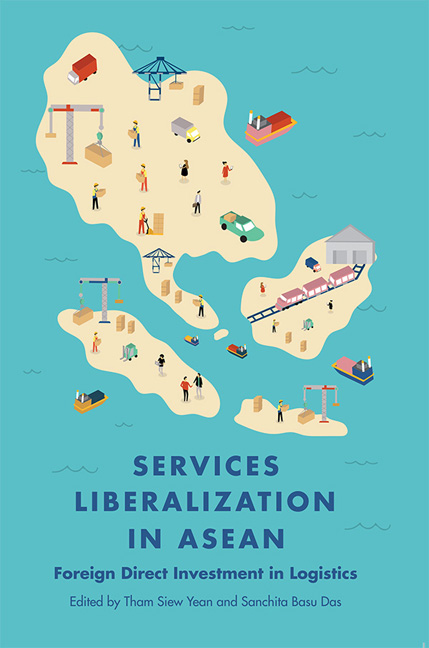Book contents
- Frontmatter
- CONTENTS
- List of Tables
- List of Figures
- Foreword
- Preface
- Acknowledgements
- Abbreviations
- About the Contributors
- 1 Introduction
- 2 Reforming Indonesia's Logistics Sector
- 3 FDI Liberalization in Malaysia's Logistics Services
- 4 Logistics Services Liberalization in the Philippines
- 5 Services Sector Liberalization in Singapore: Case of the Logistics Sector
- 6 Logistics Services Liberalization in Thailand
- 7 Services Liberalization in Vietnam: The Case of FDI in Logistics Sector
- 8 Services Liberalization: Case of Logistics in Brunei
- 9 FDI, Services Liberalization and Logistics Development in Cambodia
- 10 Services Liberalization in Lao PDR: FDI in Logistics Sector of a Land-linked Country
- 11 Facilitating FDI for the Logistics Sector in Myanmar: Agency, Incentives, and Institutions
- Index
9 - FDI, Services Liberalization and Logistics Development in Cambodia
Published online by Cambridge University Press: 04 July 2018
- Frontmatter
- CONTENTS
- List of Tables
- List of Figures
- Foreword
- Preface
- Acknowledgements
- Abbreviations
- About the Contributors
- 1 Introduction
- 2 Reforming Indonesia's Logistics Sector
- 3 FDI Liberalization in Malaysia's Logistics Services
- 4 Logistics Services Liberalization in the Philippines
- 5 Services Sector Liberalization in Singapore: Case of the Logistics Sector
- 6 Logistics Services Liberalization in Thailand
- 7 Services Liberalization in Vietnam: The Case of FDI in Logistics Sector
- 8 Services Liberalization: Case of Logistics in Brunei
- 9 FDI, Services Liberalization and Logistics Development in Cambodia
- 10 Services Liberalization in Lao PDR: FDI in Logistics Sector of a Land-linked Country
- 11 Facilitating FDI for the Logistics Sector in Myanmar: Agency, Incentives, and Institutions
- Index
Summary
Introduction
Over the last two decades, inflows of foreign direct investment (FDI) to Cambodia has increased significantly, due to its relatively liberal investment law and pace of services liberalization, including the logistics sector. Liberalization of the services sector started soon after the country's accession to the World Trade Organization (WTO) in 2004 through the General Agreement on Trade in Services (GATS) and later in 2007 through the ASEAN Framework Agreement on Services (AFAS). The services sector, accounting for 42.3 per cent of Gross Domestic Product (GDP) in 2015, plays a critical role in socio-economic development through job creation and productivity improvement. Within it, logistics is regarded as a strategic sector for national and regional connectivity, socio-economic development, and poverty reduction.
This chapter reviews Cambodia's economic development and FDI climate, along with its efforts in services liberalization. The chapter also looks at the liberalization initiatives in logistics services and the current state of logistics development and connectivity in Cambodia. Investment in logistics, especially in infrastructure, and enhancing regional connectivity is one of the key areas of national development as it can help to improve the country's economic performance and competitiveness by reducing transactions cost, improving broad investment climate, and promoting international trade.
Investment Climate
As a small economy, Cambodia has been performing well in the last two decades in terms of sustaining high economic performance and reducing poverty significantly. It has achieved a high average growth rate of 7.9 per cent from 2000 to 2015, thus making it one of the fastest growing economies in ASEAN. The poverty rate has reduced from more than 53.2 per cent in 2004 to 13.5 per cent in 2014. Per capita income has increased from US$417 in 2004 to US$1,215 in 2015, making Cambodia a lower middle-income country, according to the classification by the World Bank Group. Cambodia aims to become an upper middle-income country by 2030 and a high-income country by 2050, if it can sustain an annual growth rate of around 7 per cent.
- Type
- Chapter
- Information
- Services Liberalization in ASEANForeign Direct Investment in Logistics, pp. 268 - 296Publisher: ISEAS–Yusof Ishak InstitutePrint publication year: 2017

